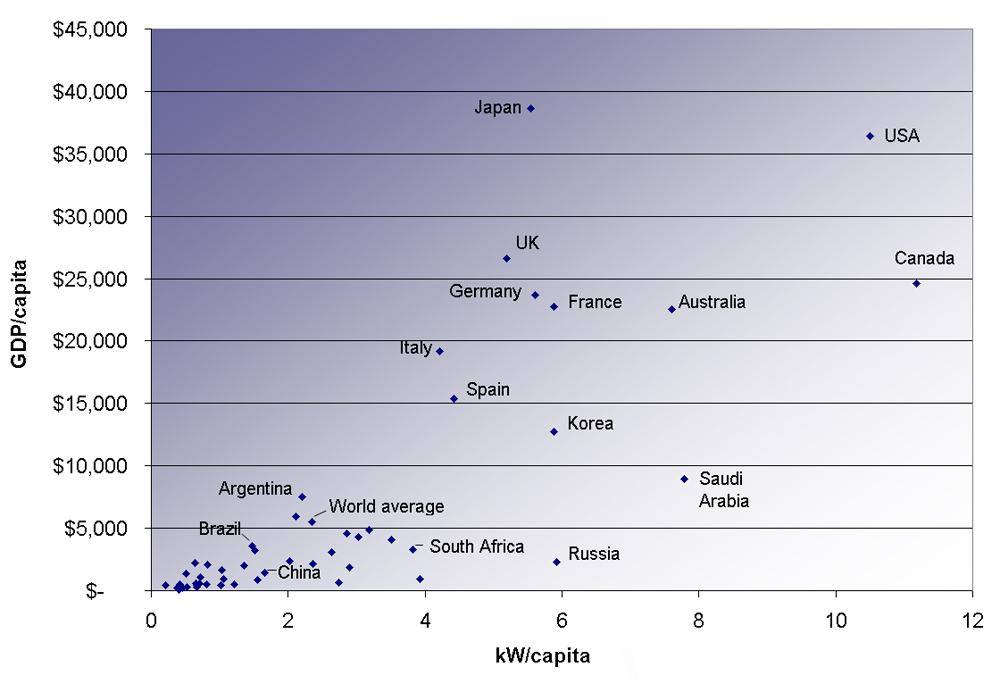Learning Objectives
Learning Objectives
By the end of this section, you will be able to do the following:
- Describe the distinction between renewable and nonrenewable energy sources
- Explain why the inevitable conversion of energy to less useful forms makes it necessary to conserve energy resources
Energy is an important ingredient in all phases of society. We live in a very interdependent world, and access to adequate and reliable energy resources is crucial for economic growth and for maintaining the quality of our lives. However, current levels of energy consumption and production are not sustainable. About 40 percent of the world’s energy comes from oil, and much of that goes to transportation uses. Oil prices are dependent as much upon new and anticipated discoveries as they are upon political events and situations around the world. The United States, with 4.5 percent of the world’s population, consumes 24 percent of the world’s oil production per year; 66 percent of the oil consumed by the United States is imported.
Renewable and Nonrenewable Energy Sources
Renewable and Nonrenewable Energy Sources
The principal energy resources used in the world are shown in Figure 7.30. The fuel mix has changed over the years but now is dominated by oil, although natural gas and solar contributions are increasing. Renewable forms of energy are those sources that cannot be used up, such as water, wind, solar, and biomass. About 85 percent of our energy comes from nonrenewable fossil fuels—oil, natural gas, coal. The likelihood of a link between global warming and fossil fuel use, with its production of carbon dioxide through combustion, has made, in the eyes of many scientists, a shift to non-fossil fuels of utmost importance—but it will not be easy.
The World’s Growing Energy Needs
The World’s Growing Energy Needs
World energy consumption continues to rise, especially in developing countries (see Figure 7.31). Global demand for energy has tripled in the past 50 years and might triple again in the next 30 years. While much of this growth will come from the rapidly booming economies of China and India, many of the developed countries, especially those in Europe, are hoping to meet their energy needs by expanding the use of renewable sources. Although presently only a small percentage, renewable energy is growing very fast, especially wind energy. For example, Germany plans to meet 20 percent of its electricity and 10 percent of its overall energy needs with renewable resources by the year 2020 (see Figure 7.32). Energy is a key constraint in the rapid economic growth of China and India. In 2003, China surpassed Japan as the world’s second largest consumer of oil. However, over 1/3 of this is imported. Unlike most Western countries, coal dominates the commercial energy resources of China, accounting for 2/3 of its energy consumption. In 2009, China surpassed the United States as the largest generator of . In India, the main energy resources are coal and biomass—for example, wood and dung. Half of India’s oil is imported. About 70 percent of India’s electricity is generated by highly polluting coal. Yet there are sizeable strides being made in renewable energy. India has a rapidly growing wind energy base, and it has the largest solar cooking program in the world.
Table 7.6 displays the 2006 commercial energy mix by country for some of the prime energy users in the world. While non-renewable sources dominate, some countries get a sizeable percentage of their electricity from renewable resources. For example, about 67 percent of New Zealand’s electricity demand is met by hydroelectric. Only 10 percent of the U.S. electricity is generated by renewable resources, primarily hydroelectric. It is difficult to determine total contributions of renewable energy in some countries with a large rural population, so these percentages in this table are left blank.
| Country | Consumption, in EJ (1018 J) | Oil | Natural Gas | Coal | Nuclear | Hydro | Other Renewables | Electricity Use per Capita (kWh/y) | Energy Use per Capita (GJ/y) |
|---|---|---|---|---|---|---|---|---|---|
| Australia | 5.4 | 34% | 17% | 44% | 0% | 3% | 1% | 10,000 | 260 |
| Brazil | 9.6 | 48% | 7% | 5% | 1% | 35% | 2% | 2,000 | 50 |
| China | 63 | 22% | 3% | 69% | 1% | 6% | 1,500 | 35 | |
| Egypt | 2.4 | 50% | 41% | 1% | 0% | 6% | 990 | 32 | |
| Germany | 16 | 37% | 24% | 24% | 11% | 1% | 3% | 6,400 | 173 |
| India | 15 | 34% | 7% | 52% | 1% | 5% | 470 | 13 | |
| Indonesia | 4.9 | 51% | 26% | 16% | 0% | 2% | 3% | 420 | 22 |
| Japan | 24 | 48% | 14% | 21% | 12% | 4% | 1% | 7,100 | 176 |
| New Zealand | 0.44 | 32% | 26% | 6% | 0% | 11% | 19% | 8,500 | 102 |
| Russia | 31 | 19% | 53% | 16% | 5% | 6% | 5,700 | 202 | |
| U.S. | 105 | 40% | 23% | 22% | 8% | 3% | 1% | 12,500 | 340 |
| World | 432 | 39% | 23% | 24% | 6% | 6% | 2% | 2600 | 71 |
Energy and Economic Well-Being
Energy and Economic Well-Being
The last two columns in Table 7.6 examine the energy and electricity use per capita. Economic well-being is dependent upon energy use. In most countries, higher standards of living—as measured by GDP (Gross Domestic Product) per capita—are matched by high levels of energy consumption per capita. This relationship is borne out in Figure 7.33. Increased efficiency of energy use will change this dependency. A global problem is balancing energy resource development against the harmful effects upon the environment in its extraction and use.
Conserving Energy
Conserving Energy
As we finish this chapter on energy and work, it is relevant to draw some distinctions between two sometimes misunderstood terms in the area of energy use. As mentioned elsewhere, the law of the conservation of energy is a very useful principle in analyzing physical processes. It is a statement that cannot be proven from basic principles, but is a very good bookkeeping device, and no exceptions have ever been found. It states that the total amount of energy in an isolated system will always remain constant. Related to this principle, but remarkably different from it, is the important philosophy of energy conservation. This concept has to do with seeking to decrease the amount of energy used by an individual or group through (1) reduced activities (e.g., turning down thermostats, driving fewer kilometers) and/or (2) increasing conversion efficiencies in the performance of a particular task—such as developing and using more efficient room heaters, cars that have greater miles-per-gallon ratings, energy-efficient compact fluorescent lights, etc.
Since energy in an isolated system is not destroyed or created or generated, you might wonder why we need to be concerned about our energy resources; energy is a conserved quantity. The problem is that the final result of most energy transformations is waste heat transfer to the environment and conversion to energy forms no longer useful for doing work. To state it in another way, the potential for energy to produce useful work has been degraded in the energy transformation. This will be discussed in more detail in Thermodynamics.




